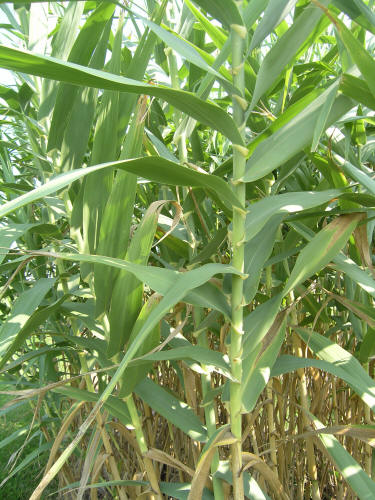Giant Reed Grass
Giant Reed Grass
Arundo donax
Poaceae (Grass Family)
▲ ▼ mature colony of giant reed
▲ ▼ individual stem with wide leaf blades

▲ flowering colony, with large, broom-like panicles
Arundo donax: Giant Reed Grass
Location near campus: in ornamental grass bed toward southwest corner of Master Gardener areas north of Botanical Center Building in Nathanael Greene park at the Botanical Center.
- Asian warm-season, clumping grass with broad, relatively short leaf blades (2-3" wide by 12-24" long)
- Leaves are medium to gray green in color; white variegated leaf forms also available
- Can increase clump/colony size by shoots from short, thick rhizomes
- Unbranched stems grow 6-25’ tall in a single growing season
- Inflorescences are dense, broom-like, silvery-gray terminal panicles produced in early fall
- Stems do not persist beyond one year--new growth always starts from the ground (in Missouri)
- Stems are not woody like bamboo, but stem pith is source of reeds for woodwind musical instruments
- Prefers full sun (can tolerate light shade), moist, well-drained fertile soils, although can grow in wetter soils
- Large leaves, stems make it a focal point in landscapes, so careful planning in using it, particularly in smaller yards, is recommended
- Is invasive in western U.S.